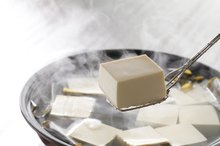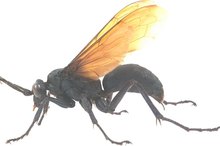Food Allergies With a Skin Rash Resembling Scratches
An allergic skin condition occurs when an allergen triggers an immune system response. As a result, a red, inflamed rash that resembles a scratch can develop anywhere on the skin, including on the face, hands, feet, back of the knees, elbows, chest and legs. Foods that may cause these rashes include nuts, fish, dairy products and some plant foods.
If you are experiencing serious medical symptoms, seek emergency treatment immediately.
Identifying the Culprits
A skin rash that resembles a scratch can be the result of hives -- itchy, raised welts on the skin that can develop when the immune system mistakes a food such as peanuts, shellfish, nuts or eggs as an allergen. The body releases histamines and immunoglobulin E antibodies into the blood. As a result, your skin can become extremely itchy and you may start to rub or scratch at your skin before the hives actually develop, which can give the appearance of scratches. Eczema, a skin condition that can be triggered by a food allergy, can also cause a scratchlike, itchy rash. Although the exact cause of eczema is not known, foods like dairy products, wheat and soy can trigger symptoms.
- A skin rash that resembles a scratch can be the result of hives -- itchy, raised welts on the skin that can develop when the immune system mistakes a food such as peanuts, shellfish, nuts or eggs as an allergen.
- Eczema, a skin condition that can be triggered by a food allergy, can also cause a scratchlike, itchy rash.
Rash and Other Symptoms
Skin Rashes and Allergies to Soy
Learn More
When caused by hives, an allergic rash can appear as large, raised welts with a pale center. If the welt gets irritated or infected, it can resemble a scratch. The skin can become red, scabby, inflamed and tender to the touch just like a scratch. With eczema, the skin can crack and crust over, leaving scratchlike marks. Besides a rash, symptoms of a food allergy can include:
- nausea
- abdominal pain
- a runny nose
- an itchy mouth
- nasal congestion
- diarrhea
- When caused by hives, an allergic rash can appear as large, raised welts with a pale center.
- With eczema, the skin can crack and crust over, leaving scratchlike marks.
Getting Help
If your rash is mild, it may disappear on its own within a few minutes or hours. Place a cold compress on the rash for a few minutes at a time to help reduce mild itching and swelling. You can also apply a soothing lotion, ointment or anti-inflammatory cream to the affected area. An antihistamine can also help soothe itching and irritation. See an allergy specialist if your skin rash is chronic. An allergist can perform blood tests, urine tests or skin tests to help identify the allergen. Eliminate the food you are allergic to from your diet. In addition, avoid all products that might contain the allergen such as skin creams or beauty products.
- If your rash is mild, it may disappear on its own within a few minutes or hours.
- Place a cold compress on the rash for a few minutes at a time to help reduce mild itching and swelling.
When It’s Dangerous
A Skin Rash on the Hands and Ankles from a Food Allergy
Learn More
Call 911 if your skin rash is accompanied by swelling of the lips, throat or tongue. In addition, get immediate help if you experience shortness of breath, swallowing difficulty, a drop in blood pressure, a weak pulse, chest pain or your skin starts to turn blue. These are symptoms of anaphylaxis, which is a life-threatening allergic reaction 2. Go to the emergency room, even if symptoms begin to subside. You may require an injection of epinephrine.
- Call 911 if your skin rash is accompanied by swelling of the lips, throat or tongue.
- Go to the emergency room, even if symptoms begin to subside.
Related Articles
References
- FamilyDoctor.org: Eczema and Atopic Dermatitis
- Parents: Different Types of Rashes
- PubMed Health: Hives
- American College of Allergy, Asthma & Immunology: Hives (Urticaria)
- National Eczema Association: Causes & Triggers
- National Eczema Association: Eczema
- The American College of Allergy, Asthma, and Immunology. Skin Allergies.
- Eichenfield LF, Ahluwalia J, Waldman A, et al. Current guidelines for the evaluation and management of atopic dermatitis: A comparison of the Joint Task Force Practice Parameter and American Academy of Dermatology guidelines. J Allergy Clin Immunol. 2017;139(4S):S49-S57. doi:10.1016/j.jaci.2017.01.009
- Smith AR, Knaysi G, Wilson JM, Wisniewski JA. The Skin as a Route of Allergen Exposure: Part I. Immune Components and Mechanisms. Curr Allergy Asthma Rep. 2017;17(1):6. doi:10.1007/s11882-017-0674-5
- Bernstein JA, Lang DM, Khan DA, et al. The diagnosis and management of acute and chronic urticaria: 2014 update. J Allergy Clin Immunol. 2014;133(5):1270-7. doi:10.1016/j.jaci.2014.02.036
- Siegfried EC, Hebert AA. Diagnosis of Atopic Dermatitis: Mimics, Overlaps, and Complications. J Clin Med. 2015;4(5):884-917. doi:10.3390/jcm4050884
- Fonacier L, Bernstein DI, Pacheco K, et al; American Academy of Allergy, Asthma & Immunology; American College of Allergy, Asthma & Immunology; Joint Council of Allergy, Asthma & Immunology. Contact dermatitis: a practice parameter-update 2015. J Allergy Clin Immunol Pract. 2015;3(3 Suppl):S1-39. doi:10.1016/j.jaip.2015.02.009
- Tilles SA. Allergic Skin Disease and the Practicing Allergist: Growing Unmet Need, New Science, and New Treatments. Immunol Allergy Clin North Am. 2017;37(1):xiii-xiv. doi:10.1016/j.iac.2016.10.002
Writer Bio
Rose Erickson has been a professional writer since 2010. She specializes in fitness, parenting, beauty, health, nutrition and saving money, and writes for several online publications including The Krazy Coupon Lady. She is also a novelist and a mother of three.








